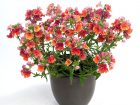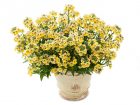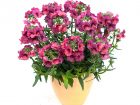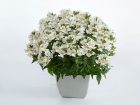
Features
Crop Culture
Inputs
Tips to Help Grow The New Nemesias For Growing Markets
Their adaptability is well known by growers, retailers and – most importantly – by consumers.
March 4, 2015 By Chanochi Zaks
 ‘Nesia Tropical'
‘Nesia Tropical' While we can, by many standards, call nemesia a classic plant due to its longevity and continued popularity, the newest varieties offer many benefits that some of the early standards could not.
Not the least of these traits is their vibrant colour range. Ever more vivid purples, oranges and pinks have joined the classic yellows and whites. Bicolours in all combinations are also appealing to markets and providing additional sales potential for growers and retailers.
Longer flowering series are also gaining attention, maintaining their floriferousness from early spring into late fall, and helping growers and retailers extend their seasons in turn. While nemesias are perennial only in the warmest of locales, even as annuals they thrive in cool weather, with their signature snapdragon flower shapes providing colour in more moderate climates.
For consumers they provide great variety with selections available offering a lovely sweet fragrance, and others unscented. They will typically reach about one to two feet tall and one foot wide, giving them appealing versatility.
WELL-SUITED IN FULL TO PARTIAL SUN CONDITIONS
Nemesias grow well in full to partial sun and require little more than regular watering to produce continuous flowering. It is no wonder Sunset magazine named nemesia one of the 17 best plants for cool-season colour.
Their adaptability lends nemesias to many uses, and the market is taking advantage. Retailers can promote them for use in mixed containers, pots, ground covers, mixed borders, edging plants, window boxes and hanging baskets.
You could also pot up some patio containers or combination pots to push sales even more.
- Create a tropical feel when you combine such cultivars as nemesia ‘Nesia Tropical’ (light orange and pink bicolour), calibrachoa ‘Noa Papaya,’ and calibrachoa ‘Noa Apricot.’
- Appeal to other customers with the classic yellow monochromatic look by blending plants such as nemesia ‘Nesia Sunshine,’ ‘Nesia Lemon,’ and petunia ‘Sunshine Ray.’
- Create a contemporarily elegant combination with varieties such as nemesia ‘Nesia Banana Punch’ (pink and yellow bicolour), sutera ‘Scopia Golden Leaves White,’ and petunia ‘Littletunia White Grace.’
- Or provide bright spring colour by pairing varieties like nemesia ‘Nesia Pink Spirit,’ argyranthemum ‘Angelic Lemon Pastel,’ and pericallis ‘Spring Touch Grape.’ They are low maintenance choices for any garden.
In the greenhouse, nemesias are known for their easy growing nature, but like any crop they have their own unique needs and requirements. A few simple tips will have you successfully producing quality nemesias in no time.
CULTURAL REQUIREMENTS
Light: For best results, provide at least 5,000 foot candles (50,000 LUX) of light for nemesias. This is the equivalent to full sunlight to partial shade.
Temperature: Nemesias will grow best with daytime temperatures of 15 to 24 C and nighttime temperatures of 10 to 14 C.
Nutrition: Nemesias are moderate feeders. Constant feed is best. Though a slightly increased level of iron is ideal, otherwise average levels of micronutrients will be sufficient. Aim for 100 to 150 ppm nitrogen in a balanced fertilizer.
Water: A moderate level of irrigation will suffice. They will be happiest in soil that is allowed to dry between watering.
PRODUCTION
Rooting: Rooting will take about two weeks (14 days). Temperatures should be maintained at 18 to 24 C. A 50 ppm nitrogen mist is beneficial, as is a drench with a broad spectrum fungicide to prevent disease activity.
Medium: Choose a disease-free, well-drained potting mix. A pH of 5.5 to 6.0 works well. Try to maintain electrical conductivity (EC) at approximately 0.6 to 0.9.
Pinching: About 10 days before liner planting, or about 10 days after planting and establishing, a single pinch is recommended. (A few of the more vigorous series may require a second pinch, but this is unusual.)
Growth regulators: We can consider the use of growth regulators optional. Under high light intensities, it will not be necessary. Of course you will want to adjust rates for your specific greenhouse conditions and required plant size.
SCHEDULING
Production of 4” (10 cm) pots will take five to six weeks with one plant per pot. Six-inch (15 cm) pots will be ready for sale in seven to eight weeks with one to two plants per pot. Plant three to five plants per 10” (25 cm) hanging baskets. They will finish in nine to 11 weeks.
PEST CONTROL
Maintaining moderate humidity levels and providing good air circulation should be part of any good preventive program. Preventing insect or disease activity starts with vigilant scouting and monitoring. For insects, monitor closely for aphids, thrips and whiteflies. Starting with virus-free material is essential, as nemesias are particularly sensitive to viruses. Diseases to watch for include pythium, rhizoctonia and botrytis.
Chanochi Zaks is vice-president of marketing for Danziger “Dan” Flower Farm. He can be reached at chanochi@danziger.co.il.
Print this page



